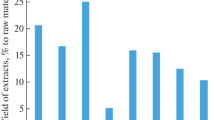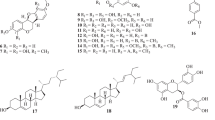The composition and antioxidant properties of aqueous and EtOH extracts of the flowers and bark of various lilac species (Syringa vulgaris L., varieties Jeanne d’Arc and Lavoisier; S. josikaea Jacq. fil.; S. microphylla superba, and S. amurensis Rupr.) were investigated. It is found that the antiradical activity does not depend on the variety and species of lilac. Thus, any of the studied species can be used as pharmacological raw material. It is established that the antiradical properties of lilac extracts are determined to a considerable extent by compounds of nonphenolic nature.
Similar content being viewed by others
References
Z. A. Ivanova, Lilac [in Russian], MSP, Moscow (2006).
K. Dlugosova nad I. Psenakova, Nova Biotechnol., 5, 185 – 197 (2004).
J. R. Borchardt, D. L. Wysel, C. C. Sheafferl, et al., J. Med. Plant Res., 2(5), 98 – 110 (2008).
S. Y. Kim, J. H. Kim, S. K. Kim, et al., J. Am. Oil Chem. Soc., 71(6), 633 – 640 (1994).
A. N. Obukhov, Medicinal Plants, Raw Material and Preparations [in Russian], Knizhnoe Izd., Krasnodar (1962).
Ukraine State Pharmacopoeia [in Ukrainian], RIREG, Kharhiv (2001).
V. L. Singleton, R. Orthofer, and R. M. Lamuela-Raventos, Methods Enzymol., 299, 152 – 178 (1999).
P. Molyneux, Songklanakarin J. Sci. Technol., 26(2), 211 – 219 (2004).
A. G. Lapinskii and V. V. Gorbachev, Khim.-farm. Zh., 40(6), 27 – 29 (2006).
Ya. I. Korenman, Extraction of Phenols [in Russian], Volgo-Vyat. Izd., Gorkii (1973).
A. A. Fedoseeva, O. S. Lebedkova, L. V. Kanibolotskaya, et al., Khim. Rastit. Syr’ya, No. 3, 123 – 127 (2008).
C. Anesini, G. E. Ferraro, and R. Filip, J. Agric. Food Chem., 56, 9225 – 9229 (2008).
S. Gorinstein, O. J. Vargas, and N. O. Jaramillo, Eur. Food Res. Technol., 321 – 328 (2007).
V. A. Kurkin, N. A. Grinenko G. G. Zapesochnaya, et al., Khim. Prir. Soedin., No. 1, 45 – 49 (1992).
Author information
Authors and Affiliations
Corresponding author
Additional information
Translated from Khimiko-Farmatsevticheskii Zhurnal, Vol. 45, No. 2, pp. 29 – 30, February, 2011.
Rights and permissions
About this article
Cite this article
Fedoseeva, A.A., Lebedkova, O.S., Kanibolotskaya, L.V. et al. Composition and antiradical activity of lilac extracts. Pharm Chem J 45, 91–92 (2011). https://doi.org/10.1007/s11094-011-0567-1
Received:
Published:
Issue Date:
DOI: https://doi.org/10.1007/s11094-011-0567-1




